This post may contain affiliate links. Please read our disclosure policy. As an Amazon Associate, I earn from qualifying purchases.
This whole grain gluten free flour blend brings a rich flavor and texture to your baked goods. No rice flour here, just the goodness of ancient grains like millet, teff, and amaranth. This homemade gluten free flour mix is balanced for consistent texture and it will store well for months.
Best of all, it’s a cup-for-cup substitute for all-purpose or whole wheat flour, so it’s a simple swap in your favorite recipes. Plus, it’s free from common allergens…. no corn, peanuts, tree nuts, rice, or dairy.
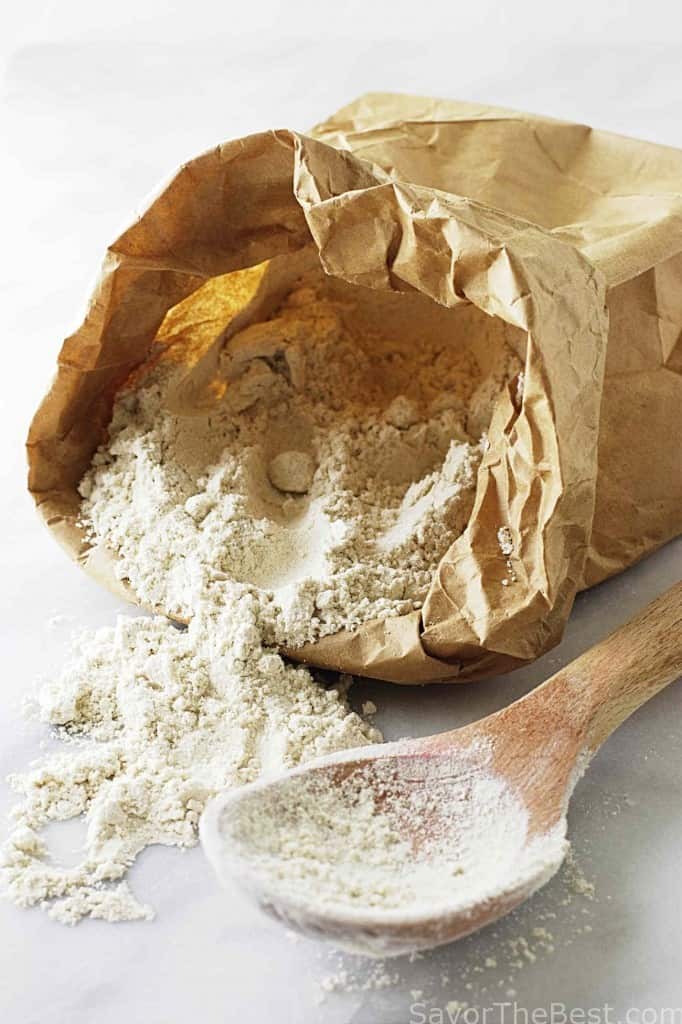
Inspired by King Arthur’s ancient grains blend, this recipe was customized through extensive testing for a high-performing, all-purpose gluten-free flour substitute.
Here is Why This Whole Grain Gluten Free Flour Recipe Works
No Rice Flour: Say goodbye to the same-old rice-based blends! This mix uses ancient grains for a deeper flavor and texture.
Stores Like a Champ: Make it once, bake for months. This blend stays fresh in the fridge or freezer, so you’re always ready to bake on a whim.
Balanced for Great Results: The combo of whole grains and starches is just right for texture—no chalky bakes here.
Perfectly Measured: Weigh it or spoon it, this mix is ready to go either way, with conversions that make sense for every baker.
The Ingredients
- Pantry Flours: Millet flour, tapioca flour, arrowroot flour, teff flour, sorghum flour, amaranth flour
- Specialty Items: Xanthan gum (for binding, moisture retention, and elasticity)
Each ancient grain brings something unique: millet adds a soft texture, teff provides structure and moisture retention, and sorghum flour gives a light crumb. The starches, like tapioca and arrowroot, add lift and keep things light.
If you prefer a xanthan gum substitute, you can use psyllium husk powder or glucomanna, just triple the amount. However, note that without xanthan, baked goods might dry out a little faster and they will be a little more dense.
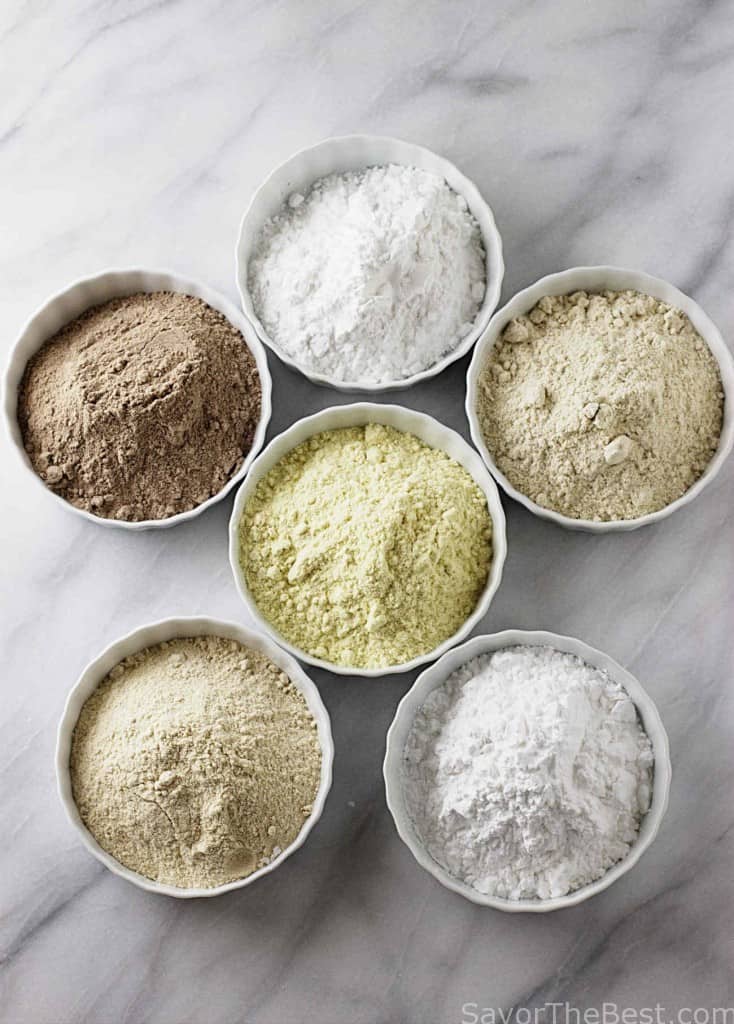
Tips for Success
- For the most accurate results, use a kitchen scale. Gluten-free flours can vary in density, so weighing ensures consistent results.
- If you’re using measuring cups instead of a scale, lightly spoon the flour into the cups and level off. Avoid packing it down, which can lead to dense results.
- Sifting or whisking the flours together helps prevent clumping and ensures an even texture in your baked goods.
- A little xanthan gum goes a long way! It adds elasticity and helps trap air for a light, fluffy texture, but too much can make your baked goods dense or even gummy.
Storage
Room Temperature: Store the flour blend in an airtight container in a cool, dry place for up to 1 month.
Refrigerator: For longer storage, keep the blend in the fridge for up to 3 months. Be sure to keep it sealed to prevent moisture from getting in.
Freezer: To extend the shelf life even more, freeze the gluten-free flour blend for up to 6 months. Use a freezer-safe, airtight container or bag. Let it come to room temperature before using, as any condensation from freezing can affect measurements and texture.
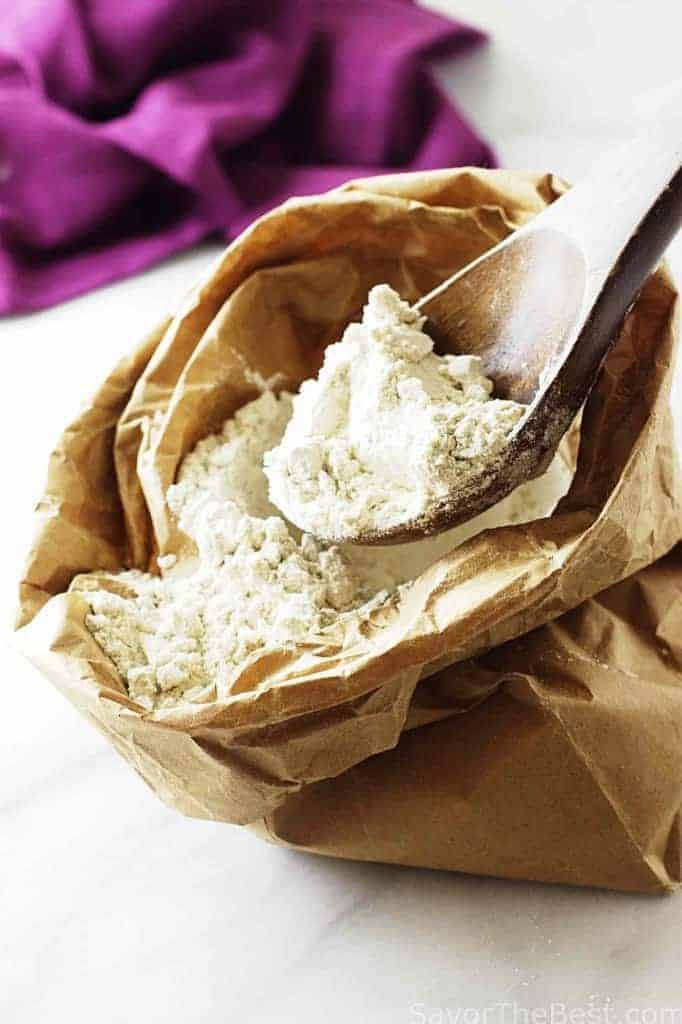
Gluten Free Flour Without Rice Flour
This gluten-free flour blend is all about flavor, versatility, and the kind of texture that doesn’t make you miss traditional flour one bit.
The ancient grains bring a bit of personality to every bake, without relying on rice flour! Plus, having this blend on hand means you’re ready to whip up baked goods whenever the mood strikes. We’d love to know what you create with it, so feel free to tag us and share your results!
Pin this now to find it later!
Pin It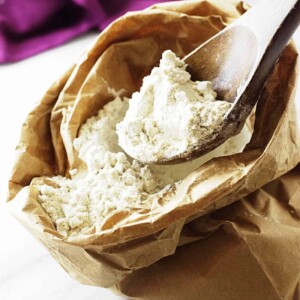
Ancient Grains Gluten Free Flour Blend
If you make this recipe, please leave a star rating and comment.
Equipment
Ingredients
- 325 grams millet flour, 2-½ cups plus 3 tablespoons
- 220 grams tapioca flour, 1-¾ plus 1 tablespoon
- 180 grams arrowroot flour, 1-½ cups plus 2 tablespoons
- 120 grams teff flour, ¾ cup
- 100 grams sorghum flour, ¾ cup
- 55 grams amaranth flour, ½ cup
- 2 ½ teaspoons xanthan gum
Instructions
- Whisk or sift all of the ingredients until well combined.
- Store in an airtight container in a cool dry place for 1 month, in the fridge for 3 months or the freezer for 6 months.
Notes
- This mix makes 8-1/3 cups of flour.
- 1 cup is equivalent to 120 grams.
- Baked goods made with this flour blend will freeze well.
- It is best to weigh your ingredients but if you don’t have a scale, lightly spoon the flours into your measuring cups.
Nutrition
Nutrition information is automatically calculated, so should only be used as an approximation.
 Like this recipe? Rate & comment below!
Like this recipe? Rate & comment below!

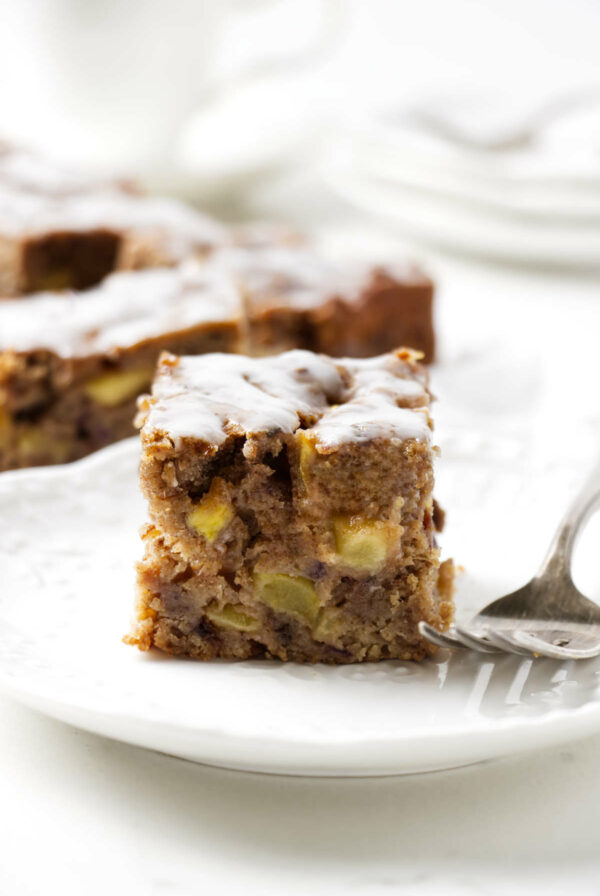
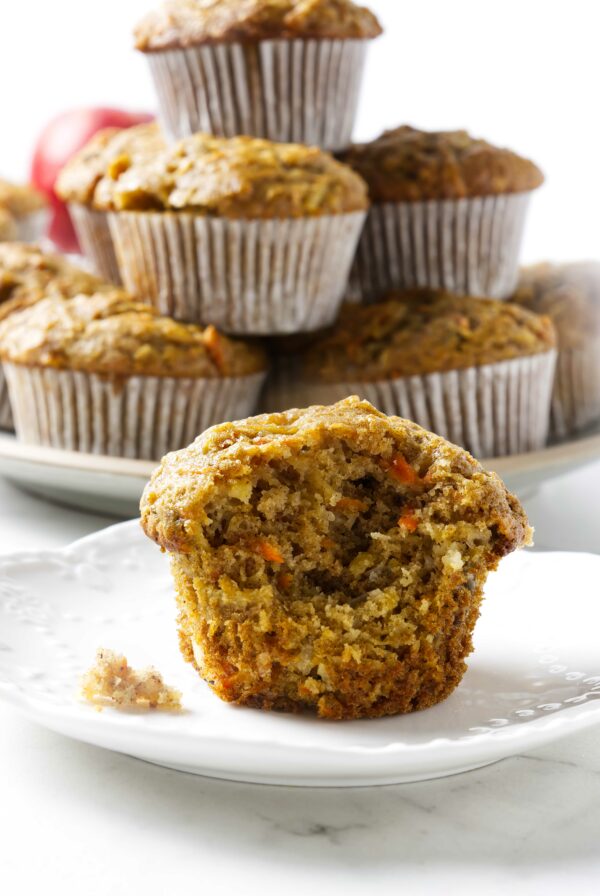
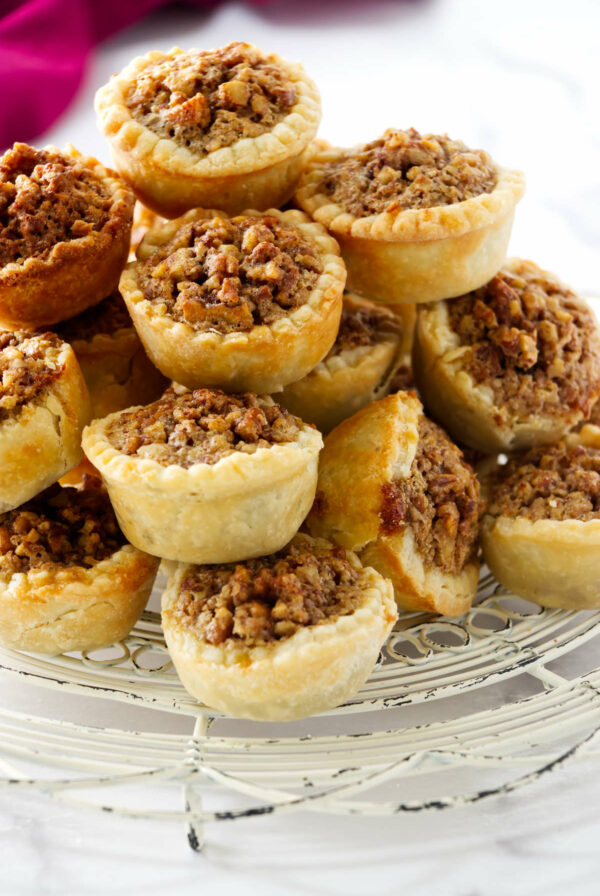
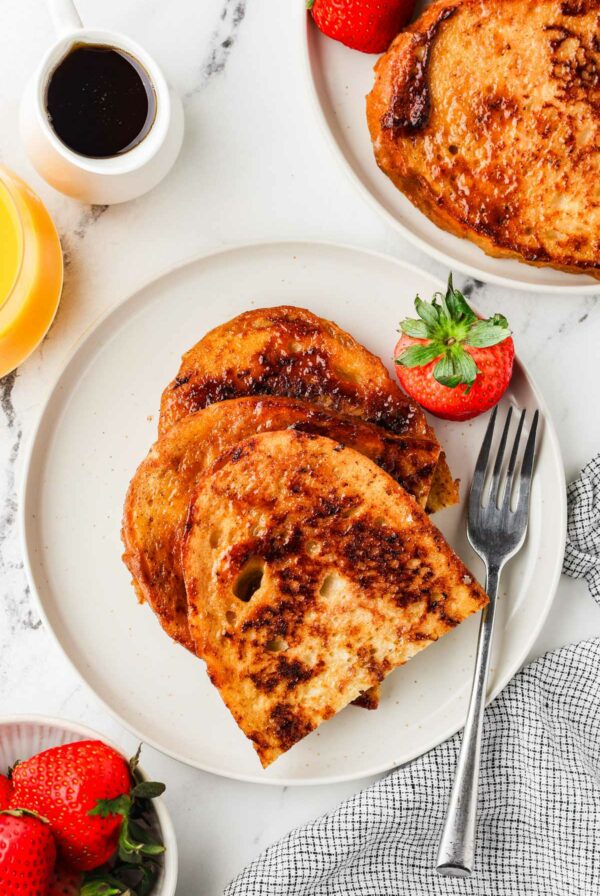










Good morning! I’ve just made this blend and can’t wait to use it! Just wondering if you can point me towards a good gluten free vegan bread recipe that this would work with please? Thank you so much :))
Gluten-free yeast bread has a much different process than standard gluten bread. This recipe works well when you substitute the flour for the ancient grains gluten-free flour blend. The important part with the recipe is to beat the batter for a MINIMUM of 5 minutes. If you are using a hand mixer then beat it for 10 minutes. Thanks for the question
Do you think Taro Flour or african Yam Flour could replace the tapioca starch? I avoid tapioca and cornstarch. Or could you just use more arrowroot?
Hey Stephanie, I wouldn’t increase the arrowroot by too much or your baked goods will seem ‘gummy’. I haven’t tried Taro or yam flour but they sound like good options. I would love to hear if you try it and how it turns out.
Hello Dahn,
I have used this bleak to make madaleine recipe by Anna Olson and it turned out great! The only issue that I am having is the distinct taste of Amarath flour. Is there anything else I can replace it with without compro this great flou mix?
Jan
Jan, if you don’t care for the flavor of amaranth then eliminate the amaranth and increase the millet by 25 grams or 1/4 cup and increase the tapioca and arrowroot by 25 grams each or about 2 tablespoons. That mix will work just fine otherwise, if you’re not sensitive to rice flour, you could replace all 55 grams of amaranth with 55 grams of rice flour. Either option will make a very nice gluten-free blend that will perform just as nicely. I’m so happy to hear the madeleine recipe turned out nicely.
Hi! I am allergic to millet…do you think light buckwheat flour or oat flour would create a suitable tasty blend for lighter vanilla based cakes…? Food allergy experimentation is *so* hard and expensive to do. Teff flour and amaranth flour are extremely expensive here where I live.
Thx!!!
Hi Ali, yes teff and amaranth can be more expensive. I always grab them when I see a sale. Your struggle with food allergy experimenting is so difficult. Buckwheat is a lovely flour for some baked goods but it can overpower the flavor of a vanilla based cake. If you can tolerate oat flour, then give that a try. Another option would be a blend of buckwheat and oat flours to replace the millet.
If i don’t use xantham gum in the blend, should I use 3 times as much (7.5 tsp) of one of the alternatives? Do you recommend one over the other? Also, do you still use baking soda or powder in a recipe that calls for it? I read one of the comments and wasn’t sure if you would still need those with this flour. Thank you!
Melissa, if you can’t use xantham gum then just omit it, no need to replace it with more of the other flours. You could replace the xanthan gum with psyllium husk powder but most recipes will work pretty well without it, especially if your recipe incorporates eggs.
You definitely still need baking soda and/or baking powder in recipes that call for one of those leaveners. This flour blend doesn’t have any leavening in it so don’t leave that out. Good luck with your GF baking. I hope to hear how it goes.
This blend sounds just like what I was looking for, but, can I use this in a bread machine? ? Bread is what I want to bake–Thank you
Hi Lore, Thanks for the question. I haven’t used a bread machine with this flour so I am not sure how it would turn out. Gluten free bread really doesn’t need to be kneaded and the bread turns out much nicer when the dough is wetter than traditional yeast bread. I have even found that gluten free bread doesn’t really need 2 rises although many recipes call for 2 rises. So for all these reasons, I haven’t tried a bread machine. It might work though. You should use a recipe specifically for gluten-free yeast bread since there are a few changes that are necessary. For instance, GF yeast bread needs a bit more xanthan gum. It also will have a better structure if you add eggs to the dough. Land O Lakes has a nice recipe that you can use this flour in. My tip would be to add an additional 1/4 teaspoon of xanthan gum to the flour. I would love to hear back if you decide to use a bread machine and how it went.
I am recently diagnosed with diabetes and hypothyroidism. The endocrinologist recommended a gluten free diet for the hypothyroidism, but I’m afraid I’ll miss out on fiber that way. It has been next to impossible trying to find proper substitutes since I am also allergic to tree nuts! This blend sounds ideal for me (higher protein, good source of fiber, complex carbs instead of simple, no nuts). If I try this flour blend, should it work as a complete substitute for making bread, pasta, baked goods?
Kirsten, bless your heart, stay strong with all your diet changes. You can do it. This blend is so great for all those reasons and you sure won’t lack in fiber with it. This blend replaces all-purpose flour very well for pasta, baked goods and yeast bread. You can use it 1:1 in recipes that call for all-purpose flour.
Hi. I liked the look of your Ancient Grains GF flour blend as it didn’t contain Buckwheat or Potato. Made some over the weekend and baked a basic Victoria Sponge.
I am very pleased. Excellent texture and taste to the cake. This could be my go to blend from now on!
Thank you!
Oh that is so good to hear. A Victoria sponge sounds AMAZING. Thanks for letting us know Angel. We love to hear what people are making with this gluten-free flour blend. It is definitely my go-to blend.
My son is on a gluten free diet but is not only allergic to wheat … he is also allergic to tapioca, rice, corn, rye, almond and several other foods. These are most relevant to this post though. I’m trying to make a good all purpose flour excluding these allergens. I have sorgum, potato flour & starch, & oat flour on hand as well as corn starch. Could I successfully blend these for baking bread?
Tracy, I have not tried blending the flours that you mentioned but I am sure you could make it work with a lot of experimenting however you mentioned that he is allergic to corn so I don’t know if you would really want to use corn starch. This recipe does not have any of the allergens you mentioned except for tapioca. You may want to try replacing the tapioca in this recipe with a mixture of potato starch and potato flour. It really takes a lot of experimenting and playing around with proportions to get the right consistency.
Good luck
I have used this blend a coup,e of times and I’m failing more in love with it. Being I live overseas buying the arrowroot is a little difficult to find sometimes. Is it possible to substitute cornstarch for the arrowroot when needed?
Yes Leah cornstarch should work as a substitute, potato starch is another alternative but I am sure the cornstarch will be easier to find. I am glad your enjoying the flour blend.